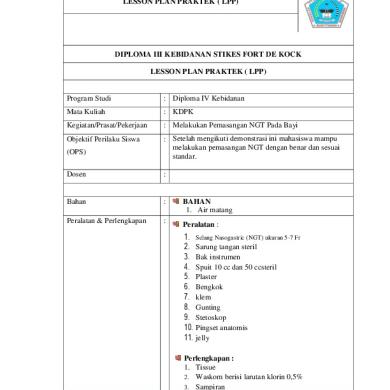Ngt Insertion
This document was uploaded by user and they confirmed that they have the permission to share it. If you are author or own the copyright of this book, please report to us by using this DMCA report form. Report DMCA
Overview
Download & View Ngt Insertion as PDF for free.
More details
- Words: 434
- Pages: 1
NASOGASTRIC TUBE INSERTION
1.
Explain the procedure, benefits, risks, complications, and alternatives to the patient or the patient's representative.
2.
Examine the patient’s nostril for septal deviation. To determine which nostril is more patent, ask the patient to occlude each nostril and breathe through the other.
3.
Instill 10 mL of viscous lidocaine 2% (for oral use) down the more patent nostril with the head tilted backwards, and ask the patient patient to sniff and swallow to anesthetize the nasal and oropharyngeal mucosa. In pediatric patients, do not exceed 4 mg/kg of lidocaine. Wait 5-10 10 minutes to ensure adequate anesthetic effect.
4.
Estimate the length of insertion by measuring the distance from the tip of the nose, around the ear, and down to just below the left costal margin. This point can be marked with a piece of tape on the tube. When using the Salem sump nasogastric tube (Kendall, Mansfield, Mass) in adults, the estimated length usually falls falls between the second and third preprinted black lines on the tube.
5.
Position the patient sitting upright with the neck partially flexed. Ask the patient to hold the cup of water in his or her hand and put the straw in his or her mouth. Lubricate the distal tip of the nasogastric tube.
6.
Gently insert the nasogastric tube along the floor of the nose and advance it parallel to the nasal floor directly perpendicular to the patient's head, not angled up into the nose until it reaches the back of the nasopharynx, where resistance will be met (10-20 (10 cm). At this time, ask the patient to sip on the water through the straw and start to swallow. Continue to advance the nasogastric tube until the distance of the previously estimated length is reached.
7.
Stop advancing and d completely withdraw the nasogastric tube if, at any time, the patient experiences respiratory distress, is unable to speak, has significant nasal hemorrhage, or if the tube meets significant resistance.
8.
Verify proper placement of the nasogastric tube by auscultating a rush of air over the stomach using the 60 mL Toomey syringe or by aspirating gastric content. The authors recommend always obtaining a chest radiograph in order to verify correct placement, especially if the nasogastric tube is to be used for for medication or food administration.
9.
Apply Benzoin or another skin preparation solution to the nose bridge. Tape the nasogastric tube to the nose to secure it in place. If clinically indicated, attach the nasogastric tube to wall suction after verification verification of correct placement. Get more nursing related downloads @ http://nursingpad.blogspot.com
1.
Explain the procedure, benefits, risks, complications, and alternatives to the patient or the patient's representative.
2.
Examine the patient’s nostril for septal deviation. To determine which nostril is more patent, ask the patient to occlude each nostril and breathe through the other.
3.
Instill 10 mL of viscous lidocaine 2% (for oral use) down the more patent nostril with the head tilted backwards, and ask the patient patient to sniff and swallow to anesthetize the nasal and oropharyngeal mucosa. In pediatric patients, do not exceed 4 mg/kg of lidocaine. Wait 5-10 10 minutes to ensure adequate anesthetic effect.
4.
Estimate the length of insertion by measuring the distance from the tip of the nose, around the ear, and down to just below the left costal margin. This point can be marked with a piece of tape on the tube. When using the Salem sump nasogastric tube (Kendall, Mansfield, Mass) in adults, the estimated length usually falls falls between the second and third preprinted black lines on the tube.
5.
Position the patient sitting upright with the neck partially flexed. Ask the patient to hold the cup of water in his or her hand and put the straw in his or her mouth. Lubricate the distal tip of the nasogastric tube.
6.
Gently insert the nasogastric tube along the floor of the nose and advance it parallel to the nasal floor directly perpendicular to the patient's head, not angled up into the nose until it reaches the back of the nasopharynx, where resistance will be met (10-20 (10 cm). At this time, ask the patient to sip on the water through the straw and start to swallow. Continue to advance the nasogastric tube until the distance of the previously estimated length is reached.
7.
Stop advancing and d completely withdraw the nasogastric tube if, at any time, the patient experiences respiratory distress, is unable to speak, has significant nasal hemorrhage, or if the tube meets significant resistance.
8.
Verify proper placement of the nasogastric tube by auscultating a rush of air over the stomach using the 60 mL Toomey syringe or by aspirating gastric content. The authors recommend always obtaining a chest radiograph in order to verify correct placement, especially if the nasogastric tube is to be used for for medication or food administration.
9.
Apply Benzoin or another skin preparation solution to the nose bridge. Tape the nasogastric tube to the nose to secure it in place. If clinically indicated, attach the nasogastric tube to wall suction after verification verification of correct placement. Get more nursing related downloads @ http://nursingpad.blogspot.com
Related Documents

Ngt Insertion
November 2019 18
Ngt Insertion
November 2019 18
Ngt
November 2019 12
Ngt Lavage
November 2019 25
Ngt Bayi.docx
June 2020 8
Pessary Insertion
November 2019 7More Documents from ""

Prc Cebu Initial Registration
May 2020 24
Needle Holders
November 2019 38
Heart Educational Advancement For Research And Training
April 2020 14
Warning Signs In Pregnancy
December 2019 21
